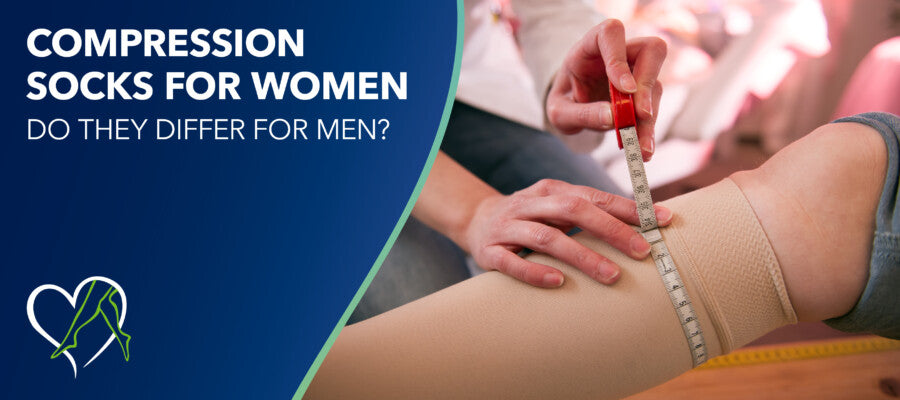
Compression Socks for Women: Do They Differ for Men?
Share
Compression stockings boost circulation and help improve overall venous health. They are often used in medical settings and have even gained popularity on social media for their increasingly wide range of aesthetics.
While people of any age can benefit from adding a pair of compression stockings to their wardrobe, these socks have a distinctive and therapeutic purpose. Understanding how they work while you discuss potential treatment options with a vein care specialist can ease some of the uncomfortable symptoms you’re experiencing and help prevent future venous problems. Compression stockings may even be covered by your insurance company.
What Are Compression Stockings for?
First, let’s talk about why people use compression stockings. As their name implies, compression stockings put pressure on the ankles and improve blood flow. This helps the tiny valves inside your veins function better by easing the major pooling of blood associated with varicose veins and other venous conditions. To put it simply, compression socks keep blood moving properly for both men and women.
How Do Compression Socks Work?
The amount of pressure applied by compression socks is measured in millimeters of mercury. The typical range is between 20 and 30 mmHg, but other compression levels are available, as per Verywell Health.
Compression stockings put pressure around the ankles and gradually ease this pressure with their height, which is essential to improving both the speed and amount of blood flow from the legs to the heart. This helps prevent the pooling issues that can lead to clotting and other serious conditions down the road. While some blood clots dissolve naturally, a life-threatening pulmonary embolism can form in a deep leg vein and break off before traveling to other areas, where they can then cause complications that may turn fatal.
Even if you don’t have a serious vein disorder or any debilitating symptoms, almost 90 percent of leg disorders develop in the veins, according to the Cleveland Clinic. This means that wearing a high-quality pair of compression socks can keep even mild symptoms at bay. The key is to stay proactive and be alert for some of the most common indicators of poor venous health, such as leg swelling, itchiness, and pain. Talk with an expert vein care specialist to determine the right amount of pressure and wear for your needs.
Although available over the counter at many medical supply companies and online, a physician sometimes prescribes compression stockings to treat venous-related swelling after certain surgical procedures. When the stockings are worn, you’ll feel a gentle squeeze that starts at the ankle and gradually decreases up to the knee or thigh.
Compression socks also come in several different lengths depending on your height and specific needs. Many of these stockings have feet and are designed to be worn as socks, although compression sleeves — stockings without feet — are common as well.
Get the Most Out of Your Compression Stockings: A Proper Fit
When putting them on, make sure your stockings lie flat against your skin and aren’t bunched up or wrinkled in any areas. You’ll also want to avoid rolling down the tops of the waist since this could affect the amount of pressure being applied and cause blood flow problems.
A vein care expert can help determine how long you should wear them, but they should be replaced every three to six months. If you have doubts, ask your physician whether you should have your legs measured when ordering a new pair. This also allows you to discuss the best compression level and height based on your current symptoms as your treatment continues.
Compression Stockings: Uses for Men and Women
The core condition compression stockings address is a condition known as chronic venous insufficiency — an umbrella term describing weakened blood vessels that have trouble pushing blood back toward the heart. Other uses for compression stockings for men and women include:
- Athletes: compression socks are typically worn to soothe muscle soreness and prevent cramping before, during, or after exercising.
- Individuals at risk for lymphedema: compression stockings can help limit fluid buildup associated with this condition and improve the way muscles move the fluid to better-draining areas.
- For those who are bedridden or have leg movement difficulties: compression stockings maintain the body’s blood circulation and decrease the risk of swelling that can otherwise become severe.
- People who spend long periods of time sitting or standing while at work: Compression socks boost circulation and lower the chances of swelling, especially for those with existing vein problems.
Don’t forget: compression stockings have long served as an essential tool to help ease the symptoms of chronic venous insufficiency during pregnancy as well. Varicose veins affect about 40 percent of pregnant women, according to the National Library of Medicine. Compression stockings can be used to address an increasingly wide range of venous conditions and the symptoms associated with them.
Treating Problem Veins in Legs with Compression Stockings
We’ve talked about the growing range of medical uses for compression stockings — but what can you expect in terms of differences for men and women when it comes to functionality, pricing, and more? They’re subtle, but they can help instill confidence when making your choice. Here’s a quick rundown on the basics:
- Appearance: Compression socks for women and men often come in differing colors.
- Pricing: While pricing will vary depending on where you’re shopping for your compression socks, you won’t find much of a cost difference between the men's and women’s sections.
- Material: Some compression stockings for men have ribbed material to imitate dress socks. Compression stockings for women, on the other hand, may have a slightly thinner or sheerer fabric.
- Sizing: The biggest difference you’ll see between men's and women’s compression socks comes down to sizing. Since men typically have larger feet, stockings specifically labeled for men will likely have longer feet.
Ultimately, choosing the right compression socks is about selecting the proper fit. According to the Cleveland Clinic, those over age 50 are at an increased risk of experiencing the uncomfortable symptoms that come with chronic venous insufficiency, and any adult with venous problems in the legs is likely to benefit from a proper-fitting pair of medical-grade compression stockings.
That said, compression therapy is just one of the many important factors in your vein care regimen. Be sure to supplement your compression stocking use with other healthy habits for the best possible results in managing your current symptoms and preventing them from getting worse over time.
Still feeling a bit uncertain about the best compression stockings for varicose veins and other conditions related to chronic venous insufficiency? The caring and compassionate physicians at Center for Vein Restoration are happy to walk you through every step of your vein health and treatment process.
Whether you’re just starting to experience symptoms, have a diagnosis, or are exploring your options, our vein care specialists will help you achieve the physical and emotional well-being you deserve.
Call our hotline today to schedule an appointment and explore your treatment options at 240-512-4945. You can also schedule ONLINE.
